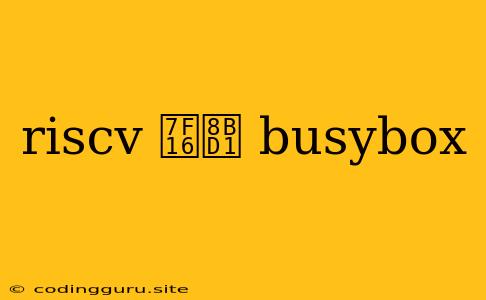Building Busybox on RISC-V: A Comprehensive Guide
Building a custom operating system or embedded environment often involves incorporating essential utilities, and Busybox stands out as a vital component. This lightweight collection of Unix tools proves immensely useful for creating a functional system within limited resources.
But how do you get Busybox working on a RISC-V platform? Let's explore the process.
Understanding the RISC-V Architecture
Before embarking on the Busybox build process, a basic grasp of the RISC-V architecture is helpful. RISC-V is an open-source instruction set architecture (ISA) gaining popularity due to its modularity and flexibility. This architecture offers various configurations, each with its own set of features, making it suitable for diverse applications.
For Busybox compilation, the most crucial element is the cross-compiler specifically designed for RISC-V.
The Role of a RISC-V Cross-Compiler
A standard compiler translates source code into machine instructions for the system where it is run. A cross-compiler, however, targets a different architecture. In this case, it translates Busybox source code into instructions compatible with a RISC-V processor.
Obtaining a suitable RISC-V cross-compiler is the first step. Several options exist, including:
- GCC: The GNU Compiler Collection supports RISC-V.
- LLVM: The LLVM compiler infrastructure also provides support for RISC-V.
Setting Up the Build Environment
Once you have your cross-compiler, you'll need a suitable build environment. Here's a general approach:
-
Install Required Packages: Make sure your system has the necessary dependencies for compiling Busybox. This typically involves packages for the cross-compiler, C development tools, and build utilities like
makeandautoconf. -
Create a Build Directory: To keep your build process organized, create a dedicated directory for your Busybox project.
-
Configure the Cross-Compiler: Set environment variables to inform your system about the cross-compiler's location. For example:
export CC=riscv64-unknown-linux-gnu-gcc -
Download the Busybox Source Code: Obtain the Busybox source code from the official website or through a Git clone.
-
Configure Busybox: Enter the Busybox directory and run the
configurescript. This step adapts Busybox to your system's specific requirements../configure --target=riscv64-unknown-linux-gnu
Compiling Busybox
After the configuration step, compile Busybox using the make command:
make
This will create a Busybox binary, often named busybox.
Installing Busybox
To install Busybox on your RISC-V system, you'll need to use a suitable installation method. There are a few options:
- Static Linking: Create a statically linked Busybox binary that bundles all its dependencies. This can make it easier to deploy, but it increases the binary's size.
- Dynamic Linking: Install Busybox as a set of dynamic libraries. This generally keeps the size smaller but requires ensuring that the necessary libraries are present on the target system.
Testing Busybox
After installing Busybox, it's essential to test its functionality. You can run basic commands like ls, pwd, or date to ensure everything is working as expected.
Examples
Here are some examples of common commands you can use within Busybox:
# List directory contents
busybox ls -l
# Print the working directory
busybox pwd
# Display the current date and time
busybox date
Troubleshooting
If you encounter issues during the build process, here are some common troubleshooting tips:
- Cross-Compiler Compatibility: Double-check that your cross-compiler is correctly configured and compatible with your RISC-V target.
- Dependencies: Make sure all necessary development packages are installed.
- Build Errors: Review build error messages carefully. They often provide clues about the problem.
Conclusion
Building Busybox for a RISC-V platform involves a few crucial steps. Understanding the role of a RISC-V cross-compiler, setting up a suitable build environment, and configuring and compiling Busybox correctly are essential.
By following these steps, you can successfully create a functional Busybox installation for your RISC-V system, enabling you to deploy a wide range of useful utilities for your project.
